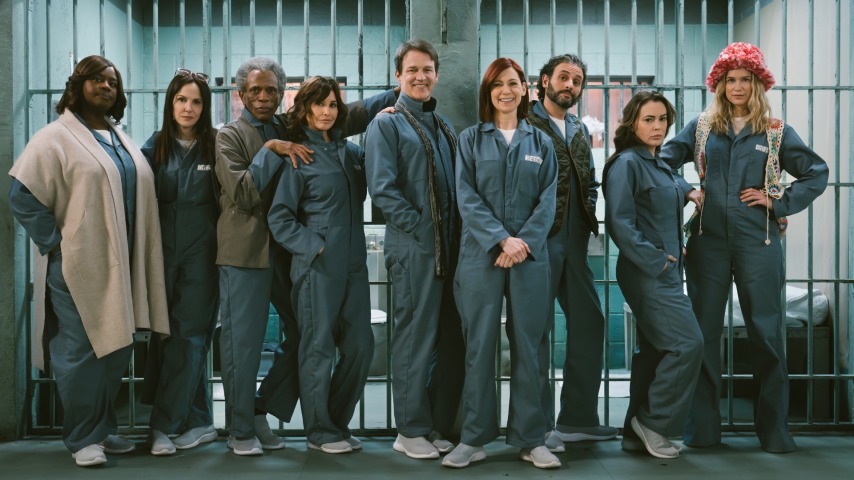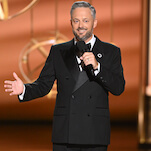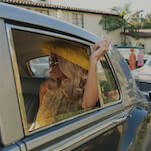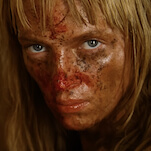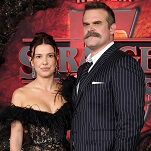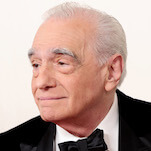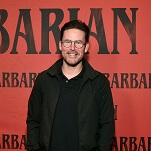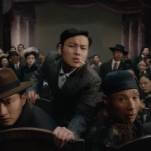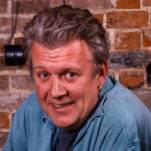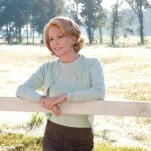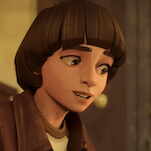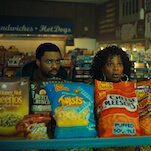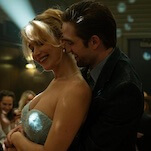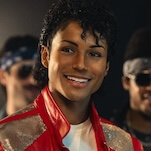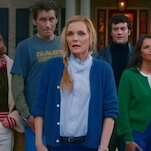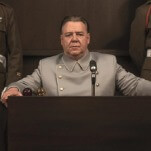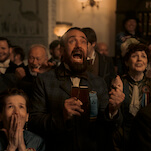AVC: What was it like to film the song-and-dance routine with everyone?
CP: Being there with all of those incredible guest stars, whom I had forged relationships with and went out of my way to make sure that they felt welcome the first time they were on the show, was a wonderful reunion. Some of them didn’t know each other, so in between takes, we were all just having the best time. It was mostly just the women. We were all talking and gossiping about everything, from business to our personal lives. The finale is my favorite episode because of that social experience.
JT: I also want to add that with Stephen Moyer, his schedule was complicated because he’s on another show right now, and also we didn’t think of him being in the musical number because his character is dead by that point. But he wrote to me and said he was free on the day we were filming the dance and that he could be in it.
AVC: What was the process like of infusing your own lyrics into “Cell Block Tango” and making them in line with Elsbeth’s vibe?
JT: The rule we have when we’re putting together our cases in every episode is that everything has to come from the specificity of the world that we’re in and the characters we’re introducing that week. The goal is always found in getting as specific as possible, and I applied that here like when Quinn [Elizabeth Lail] tells Elsbeth about how when Alex [Moyer] came onto her, he was bragging about his connections at Vanity Fair, when in reality he just sat behind Tina Brown at a Miramax screening. Digging into character details like these is always fun. Of course, while the material is different, we wanted it to be in the style and feel of the original Fred Ebb song. I worked on Apple TV+’s Schmigadoon!, and I did the same thing for the ballet number in season two. It’s fun to do these because it’s so specific, but for people who know the original song, they might get an extra kick out of it.
AVC: How did you figure out everyone’s shiny prison outfits for the dance?
JT: A great thing about our crew is everybody loves to pitch and come up with their own fun thing to add to the story. Our costume designer, Dan Lawson, was excited about the musical number and immediately wanted to bedazzle the uniforms. The other fun thing, if you notice, is that all the prisoners’ uniform numbers correspond with that character’s episode.
AVC: Were there other former guest stars you hoped to get for the finale, like Pamela Adlon, whose killer chef character is name-checked in the episode?
JT: It was just a matter of scheduling, to be honest. Some people wanted to be on it, and just couldn’t work it out, or a few people who have been murderers on our show are doing things like a musical in London right now. Thankfully, the way it landed feels very natural and organic.
AVC: What was the rehearsal process like for the musical number?
CP: Our choreographer, Susan Misner, worked with everyone individually and together before we shot. She’s a brilliant dancer and was able to somehow put it all together. The actors recorded their vocal work separately, and then they were all so committed. Even when I was doing other scenes with some of them, the rest would go off to the side [to practice]. We also shot the musical on the last day of the season, which was a really fun way to go out. By the time we got to filming, Susie was right there with all of us, along with [episode director] Lionel Coleman.
JT: I was just going to say, shout-out to Lionel. He really grasps the tone of the show. He plays it straight, but knows what’s funny and lets people do their thing. He is also such a lovely human being and makes the set atmosphere so wonderful. I think our original schedule to film “Cell Block Tango” was about six hours, and we may have gone slightly longer, but we made the day and didn’t go over time. The singing was prerecorded, and all the monologues were done live. It was amazing. We were shooting the finale’s closing scene, with Kaya’s goodbye part, on a stage at the same time as when the guest stars were learning their choreography. It was like being on the MGM lot.
CP: Yeah, the very last shot we filmed was everyone dancing and wrapping me up in boas and jumping around in front of the crew. It was the most joyous way to sum up season two.
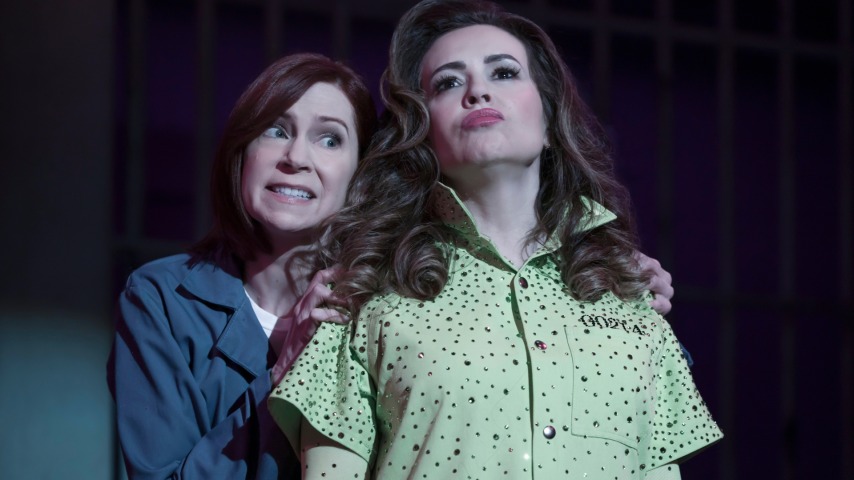
Photo: Michael Parmalee/CBS
AVC: Another great finale scene is when the prisoners put on a play about Elsbeth as she looks on. Carrie, what was it like observing that? Did you give pointers to Elizabeth Lail about playing you?
CP: I mean, these actors did not need my help. They’re at the top of their game. Filming that part was one of my favorite days of the whole episode. I got to just sit there and watch the scene unfold in front of me. We were all cracking up the minute that Elizabeth came out and poked around with the hat like me. Everybody just died laughing. We knew we were in great hands with that. Usually, I’m the one who’s having to drive the scenes, so it was like a vacation for me to sit back and watch all of these geniuses take over that day. I yielded the show to them.
AVC: Have you guys started planning season three yet? And do you have a wishlist for any actors you’d like to play killers in it?
JT: I have absolutely no idea. It’s still early for season three. I finished the final sound mix of the finale so recently, and we start writing the next season on May 19. So this is my only time I’m trying to try not to think about Elsbeth for a little bit. In general, we don’t start with an angle of “Let’s write a show for so and so.” I’m hoping we might be able to start doing that, but usually we start with the character and the story, and then we see [about casting]. There are occasional cases like Matthew Broderick. He is someone I’ve worked with before and is a friend of mine, and I knew it would be hard to lock him in. I pitched him a few season-two episodes and figured out when he’d be available, and then I wrote his episode. I’d love to do more of that if we know someone, but what’s most important is writing a narratively rich character so if you don’t end up with the person you thought, it’s still a great part that somebody else will be attracted to. When you’re doing 20 episodes, you’re moving so fast. So it’s necessary to start with the story and build something good so you can get these great actors.
AVC: The show’s tone is breezier and more comforting than The Good Wife and The Good Fight, although Elsbeth also tackles heavy topics. Can you talk about the efforts to walk that tonal tightrope?
JT: So much of it is instinct. It’s not a conscious decision. We’re all about what feels right, and we’re lucky to have Carrie Preston as the lead because she can play anything and always make it real and heartfelt. One of the things I’m most proud of, especially this season, is that this show can contain a scary assassination in episode 18 that rocks Elsbeth’s faith in the system, and then two episodes later, the show ends with a joyous musical number. And they both feel like Elsbeth. There were seeds of this kind of thing in The Good Wife and The Good Fight. I worked on TGF, and we had a few musical interludes, and I remember writing the lyrics for a musical number for John Cameron Mitchell. The Kings have set up this model where you can be a little freewheeling, which is great because it keeps things from ever feeling stale or like you’re just running the same formula.
AVC: Elsbeth Tascioni is a remarkably positive protagonist for a TV series that deals with murder.
CP: Yeah, she’s got an infectious energy. She’s positive and curious and has an eagerness to be out in the world and experience things, even if they’re unpleasant and make you feel vulnerable. She would rather do that than hide herself. It’s present in the way she dresses, expresses her feelings, and the way she lets the world land on her so beautifully. It’s inspiring for me as a person. We’ve deepened that as we’ve gone along. On The Good Wife and The Good Fight, she was there to serve that story and to come in when they needed her to save the day, so to speak. In this show, we get to see how she handles challenges, friendships, and being a mom. Of course, her biggest relationship in life is with her work. I love that she loves it so much and that she’s reinventing herself within it. There’s an infinite source of material and connection there.
We wanted her to have this journey that really started with episode 18 when Judge Crawford [Michael Emerson] gets killed in front of her. How is it affecting her relationship with justice? She gets her groove back when she gets to jail and finds this mission of solving Alex’s murder and finds her joy again, too. It was a very important moment because we wanted to show emotional depths to Elsbeth, but we also wanted her default mode to be very positive and joyful. I think we were able to achieve that.
JT: One of the things that I find people say to me so often is that Elsbeth is just the show we need right now. I had that in my head when I was writing the final speech of the finale, that we need this enthusiasm, kindness, joy, and an adherence to truth right now. We’re lucky to work with that type of character.
